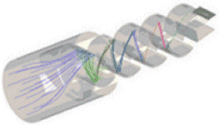Lorentzby Integrated Engineering Software
LORENTZ is a 2D/3D electromagnetic analysis software tool for applications requiring charged particle and beam analysis. Utilizing the innovative Boundary Element Method (BEM) technology, combined with a powerful user interface and post processing, LORENTZ alleviate the shortcomings of traditional finite difference-based packages.
 LORENTZ, the 2D/3D electromagnetic analysis software tool, puts you at the forefront of CAE design technology for applications requiring charged particle and beam analysis. Utilizing
our innovative Boundary Element Method (BEM) technology, combined with a powerful user interface and post processing helps LORENTZ alleviate the shortcomings of traditional finite difference-based packages. LORENTZ, the 2D/3D electromagnetic analysis software tool, puts you at the forefront of CAE design technology for applications requiring charged particle and beam analysis. Utilizing
our innovative Boundary Element Method (BEM) technology, combined with a powerful user interface and post processing helps LORENTZ alleviate the shortcomings of traditional finite difference-based packages.
The Boundary Element Method speeds up response time, reduces the need for large amounts of input data, allows for more accurate calculation of derived functions of potential, and has the ability to deal with open region problems.
Our research and development professionals designed LORENTZ to help solve the specific problems inherent
in the design and analysis of charged particles in the presence of electrostatic and/or magnetostatic fields.
Design engineers can depend on LORENTZ for the design and analysis of charged particles that incorporate
electrostatic and magnetostatic components, including:
- CRT and X-ray tubes
- high energy particles in nuclear applications
- cyclotrons, klystrons and accelerators
- ion implantation, electron lithography and disk sputtering
- electron gun design
- mass spectrometers
- magnetrons
- high voltage corona effects
Quick, productive...up and running in no time
LORENTZ maximizes productivity by allowing for the simulation of virtual prototypes on the computer. LORENTZ significantly reduces design and prototype costs and provides engineers far greater insight into design optimization and verification.
As easy as one, two, three
LORENTZ provides fast accurate results, exact modeling of boundaries and easy analysis of open region problems. No Finite Element Mesh (FEM) is required. LORENTZ delivers a powerful, easy-to-use design and analysis tool right to your desktop. LORENTZ goes to work in just three easy steps.
- Create your design through our geometric modeler or import from your CAD program.
- Assign the physical attributes of the model.
- Analyze the model, display the results and optimize for performance.
Advanced technical features
- Intuitive and structured tool-bar interface maximizes productivity for experts and beginners
- Classical or relativistic modes
- Choice of four different algorithms for calculating trajectories
- Constant and/or time-harmonic biased magnetostatics
- Highly accurate field calculation based on a Boundary Element Method solver
- Batch function allows unattended solution of multiple particles
- Built-in energy unit system includes eV, KeV, MeV, and GeV units such as time, length, etc., can be customized by the user
- Periodic and symmetry features minimize modeling and solution time
- Beam based analysis enables the user to group the trajectories in terms of beams
- A variety of display forms including graphs, contour plots, arrow plots, color maps and vector loci plots
- High quality graphics and text utility for preparation of reports and presentations
- Data exportable in formatted files for integration with spreadsheets and other programs
- Powerful parametric feature allows definition of variable parameters to be stepped through, allowing the analysis of multiple ?what-if? scenarios and facilitating design optimization
- Beam based analysis enables the user to group the trajectories in terms of beams
- Particle interaction with gravity, fluid viscosity and particle mobility
- Capable of handling multiple emitters and collector scenarios
- Capable of handling space charge effects
- Capable of handling several emission regimes, Fowler-Nordheim, Child?s saturation, limited current and Richardson-Dushman thermal emission
|

